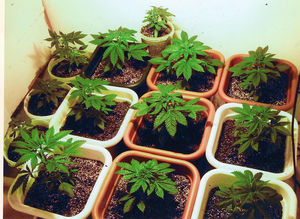Plant propagation is to reproduce, multiply or generate another plant. It is simple to see why a gardener, or anyone for that matter, benefits from making one plant two, or even more. It is not so simple to explain all of the ways propagation can take place.
There are two main types of methods to propagate plants. Sexual propagation, which is the natural process a plant uses to make seeds with or without human intervention, and asexual reproduction, which is broken into various sub-categories of techniques. Asexual propagation is also sometimes called vegetative propagation, and can be done by cloning using cuttings, dividing, layering, or grafting.
Sexual propagation of plants is the least work intensive and simple method. Sexual propagation of a plant begins with pollination. (This is assuming you have an existing plant, otherwise your process would begin and end with a seed.)
Pollination:
Pollination is achieved by taking pollen from the stamen of a flower and placing it on the stigma. Stamen will be tube or stalk like appendages just inside the petals of the flower with sticky bulbs of pollen at the end. The stigma is the uppermost part of the pistil that will be in the center of the flower.
Many plants can be self-pollinated, meaning the pollen from one flower is used to pollinate the same flower’s stigma. Plants can also be cross-pollinated, which means the pollen from a different flower is used to pollinate another plant. Cross-pollination makes for stronger plants.
In many cases, plants can be pollinated with no human interference. Wind, bugs, and animals can all pollinate a plant. If you want to ensure pollination, hand pollination can also be performed. If you desire to self-pollinate shaking the plant 2-3 three times a day while in bloom is sufficient. For cross-pollination take a paintbrush and gently brush the stamens of the plant until pollen is visible of the bristle, and then paint this pollen in the stigma of the plant you wish to pollinate.
Seed Collection:
Some time after pollination flowers will die and form a seed pod. Wait until the pod becomes dry and paper-like, and then use a paper bag and scissors to collect the pods. Place the paper bag in a dry location for two to three weeks. Once dry simply tap the seeds out of the pods. Now you have seeds to propagate another plant.
Now that you have the seeds, they need to be germinated and planted, but that’s a whole other topic.
Cloning Plants:
Probably the most common method of propagation, is called cloning or cutting. This method entails taking a piece of one plant and growing it into another plant. Cloning is a great method if the plant you want to reproduce is not your own. Be sure you ask the owner before taking a cutting.
Cuttings can be taken in a number of ways for cloning. They are as follows:
Stem Cuttings:
Using sharp scissors detach a piece of stem 2-6 inches in length. Clear leaves from the base and place in soil. You may also dip the end in rooting hormone if desired.
Root Cuttings:
Dig up the parent plant when dormant and cut a large piece of root mass 2-3 inches in length. Re-plant parent plant and root section. This method also may not work in all rose plants and has a lower success rate than stem cuttings.
You may also start plants in water until roots are well established.
Layering Plants:
Plants can be forced to propagate, this is called air layering. To use this method split the stem of the plant about 2/3 of the way through. Wedge moss into the wound and wrap with more moss covered by a dark plastic bag. Keep the moss moist until new roots begin to grow. Once roots are well established, detach the portion the rest of the way and plant.
Grafting Plants:
Grafting is the most difficult method of propagating a plant. This method doesn’t necessarily form a new plant either, rather combines more than one plant. Using grafting you can have one rose, for instance, grow five different colors of rose.
Grafting can be done in a number of ways only the easiest method will be covered here. That method is called whip and tongue grafting. When grafting the plant you are attaching the new plant too is called the rootstock and the plant you are attaching is called the scion. Make a 2 1/2-inch long diagonal cut at the top of the rootstock. Then make a matching cut on the bottom of the scion. On the cut surface, slice downward into the stock and up into the scion so the pieces can interlock like puzzle pieces. Fit the pieces together securely and as close as possible and then wrap with plastic graft binding tape.
You may also enjoy:
How to Grow Hydroponically
The Benefits of Mulching
Sources:
http://www.mrgrow.com/Tips/tip597.htm
http://www.mbgnet.net/bioplants/pollination.html
http://hubpages.com/hub/Self-Pollination-Hand-Pollinate-How-to-Pollinate-Plants-Manually
http://www.learn2grow.com/gardeningguides/propagation/techniques/HowToHarvestSeed.aspx?page=2
http://www.mastergardenproducts.com/gardenerscorner/new_page_4.htm
http://ag.arizona.edu/pubs/garden/mg/propagation/grafting.html
http://www.mahalo.com/how-to-propagate-plants
(Note the author of this piece wrote this source, so it was not plagiarized.)


